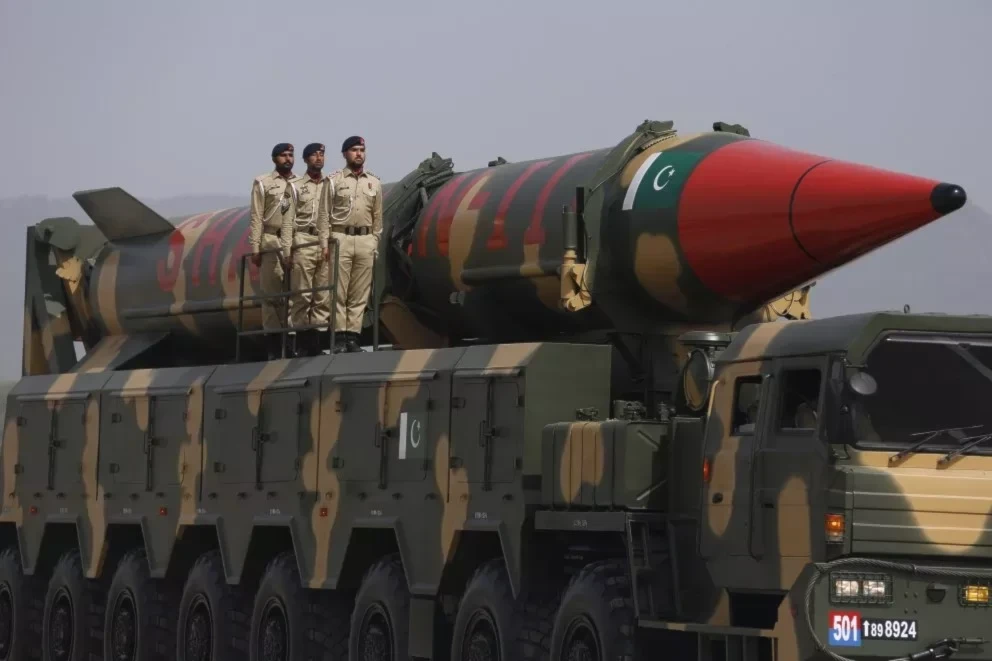India and Pakistan trade accusations over nuclear arsenal safety
India and Pakistan exchanged accusations over nuclear weapons management following intense clashes in Kashmir, raising global concerns and calls for IAEA oversight amid a fragile ceasefire.
-

A Pakistani-made Shaheen-III missile capable of carrying nuclear warheads is displayed during a military parade in Islamabad on March 23, 2022. (Anjum Naveed/AP Photo)
India and Pakistan have exchanged serious accusations about the safety and control of their nuclear weapons, following intense military clashes in the Kashmir region. The tensions have raised global concerns about the risks of nuclear mismanagement amid a fragile ceasefire.
The conflict escalated after India launched strikes on May 7 against what it described as “terrorist camps” in Pakistan, following an attack in Indian-occupied Kashmir that killed 26 civilians in Pahalgam. India blamed Pakistan for supporting the militants involved, a charge Islamabad denied.
Four days of intense drone, missile, and artillery exchanges resulted in nearly 70 deaths, including civilians on both sides.
Indian Minister Rajnath Singh called for Pakistan’s nuclear arsenal to be placed under the surveillance of the International Atomic Energy Agency (IAEA). In response, Pakistan accused India of nuclear material theft and illicit trafficking, suggesting the existence of a black market for sensitive materials.
It is worth highlighting that both countries are members of the IAEA, which regulates nuclear use globally.
Nuclear capabilities and restraint amid conflict
Both India and Pakistan have steadily expanded their nuclear arsenals since the 1990s, with India developing intermediate- and long-range missiles capable of striking targets across the region, while Pakistan has focused on a diverse missile program, including short- and intermediate-range systems designed for tactical and strategic use.
Pakistani officials have repeatedly stated that nuclear weapons are not on the table in the conflict, emphasizing the devastating consequences of escalation.
Global leaders, including US President Donald Trump, have urged restraint amid fears of escalation between Pakistan and India, as a ceasefire brokered on Saturday has largely held despite initial violations.
India holds a conventional advantage with over 1.4 million active personnel and an $86 billion defense budget, while Pakistan focuses on securing its western border and relies heavily on Chinese arms. That said, rugged terrain limits large-scale operations, but both invest in surveillance and drone technology.
The presence of nuclear arsenals significantly heightens the risks in the region. India adheres to a no-first-use doctrine and possesses a growing arsenal of long-range missiles, while Pakistan retains the option of first use and emphasizes tactical nuclear weapons.
Meanwhile, shifting defense partnerships reveal evolving geopolitical alignments: India is steadily diversifying its arms imports, moving away from traditional reliance on Russia toward the United States and France, whereas Pakistan has become increasingly dependent on Chinese military support. This widening military imbalance is driving Pakistan to explore alternative strategies to offset India’s expanding conventional and strategic capabilities.
Pakistan’s Prime Minister Shehbaz Sharif expressed concerns over provocative remarks from the Indian leadership, calling for peaceful dialogue. The longstanding Kashmir dispute continues to fuel tensions, with militant operations and counterinsurgency actions ongoing in the region.

 3 Min Read
3 Min Read








